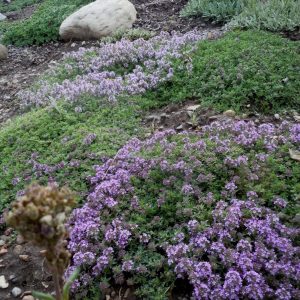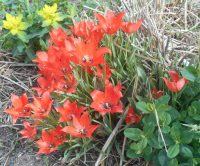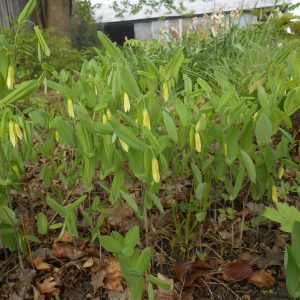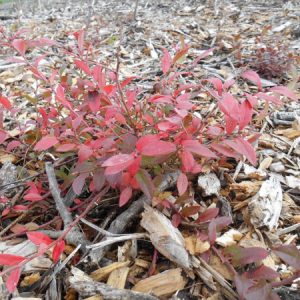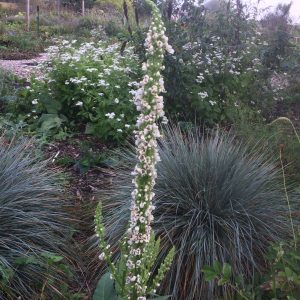Archives
Showing 153–160 of 164 results
-
Thymus serpyllum ssp. arcticus syn. T. praecox Lemon thyme Z 2-9
Purple flowers May – August with evergreen foliage on this tiny leaved plant. Good for groundcover or rock garden.
ARCHIVED
Note: This is a plant not currently for sale. This is an archive page preserved for informational use.
Purple flowers May – June with evergreen foliage on this tiny leaved plant. Good for groundcover or rock garden.
Can not ship to: Maryland
Size: 4” x 12” and spreading
Care: sun to part shade in moist well-drained to well-drained soil
Native: Greenland, Norway, Iceland, the Arctic, much of the US incl WI.This species collected on an expedition in the Arctic before 1855.
-
Trillium luteum Yellow Trillium Ephemeral Z 4-8
Sometimes mottled, hosta-like leaves support a lemon-scented, three-petaled yellow blossom in April-May
ARCHIVED
Note: This is a plant not currently for sale. This is an archive page preserved for informational use.
Sometimes mottled, hosta-like leaves support a lemon-scented, three-petaled yellow blossom in April-May
Size: 15” x 8”
Care: Shade to part shade in moist, well-drained soil
Native: Southeastern US
Wildlife Value: Attracts bees
Awards: Elisabeth Carey Miller Great Plant Pick, recipient of the Royal Horticultural Society Award of Garden MeritFirst published description by Gotthilf Heinrich Ernst Muhlenberg (1753-1815) American botanist Lutheran minister and college president.
-
Tulipa linifolia Flax-leaf tulip Z 3-8
Striking scarlet species tulip
ARCHIVED
Note: This is a plant not currently for sale. This is an archive page preserved for informational use.
Striking scarlet species tulip with target black centers, flowering in mid to late spring. Unlike today’s hybrids these come back year after year and multiply in happy locations.
Size: 6" x 4"
Care: sun in well-drained to moist well-drained soil
Native: Uzbekistan, northern Iran and Afghanistan.In late 1500’s herbalist Gerard detailed tulips’ culinary qualities,” The roots preserued with sugar, or otherwise dressed, may be eaten, and are no vnpleasant nor any way offensiue meat, but rather good and nourishing.” (This is not a suggestion that you eat the bulbs, rather, they are for planting adding spring beauty to your garden.) This species 1st described in 1884 by German botanist Eduard August von Regel (1815-1892) who served as the Director of the Imperial Botanical Garden of St. Petersburg Russia.
-
Uvularia grandiflora Largeflower bellwort, Fairybells Z 4-9
Graceful, hanging pale yellow bells, like a gypsy’s skirt, in spring
ARCHIVED
Note: This is a plant not currently for sale. This is an archive page preserved for informational use.
Graceful, hanging pale yellow bells, like a gypsy’s skirt, in spring
Size: 10-20” x 6” spread slowly
Care: part shade to shade in moist to moist well-drained soil
Native: Quebec to Ontario, NH to ND, Louisiana to Georgia, Wisconsin native
Wildlife Value: Attracts bees
Awards: Royal Horticultural Society Award of MeritMenominee reduced swelling with this plant. Ojibwa cured stomach pains and Potawatomi mixed it with lard to cure sore muscles & backaches. Collected for gardens by 1802. Wm. Robinson considered this a “graceful perennial … the finest of the species.”
-
Uvularia sessilifolia Merrybells Z 4-8
Elongated cream colored bells dangle under lily-like leaves in April-May
ARCHIVED
Note: This is a plant not currently for sale. This is an archive page preserved for informational use.
Elongated cream colored bells dangle under lily-like leaves in April-May
Size: 6-10” X 8”
Care: Sun to shade in moist, well-drained acidic soil
Native: Eastern & central North America, Wisconsin native.
Wildlife Value: attracts bees & other pollinatorsGrown at Elgin Botanic Garden, America’s 1st botanic garden, 1811. Cherokee made a tea from the roots to treat diarrhea; made a poultice for boils and cooked and ate the leaves. Iroquois made a tea from roots to purify blood and a poultice to mend broken bones. It is taken internally to aid in healing broken bones. Ojibwa used root in hunting to bring deer closer. Collected before 1753.
-
Vaccinium angustifolium Lowbush Blueberry Z 2-6
Urn-shaped white flowers in May and June turn to glossy blue berries. Foliage turns fiery red in fall. This is the true native bearing small, intensely flavored blueberries.
OUT OF STOCK
Note: This is a plant not currently for sale. This is an archive page preserved for informational use.Urn-shaped white flowers in May & June turn to glossy blue berries. Foliage turns fiery red in fall. The true native, bearing small, intensely flavored blueberries.
Size: 2-12” x 3’ spreading by runners
Care: sun to part shade in moist well-drained, very acidic soil. Mulch, roots shallow & wide spreading.
Native: entire NE of No. America as far west as Minnesota & South to N. Carolina, Wisconsin native.
Wildlife Value: nectar source for butterflies esp. Zebra swallowtail Food source for moth caterpillars, terrestrial turtles, numerous birds (Turkey, Blue Jay, Bluebird, Wood thrush & Robin) and numerous mammals. Deer & rabbits like the branches & leaves. Habitat for ground nesting birds.
Awards: Cary Award Distinctive Plants for New EnglandDescribed in literature, 1789. Many Native Americans ate the berries (fresh or dried) or mixed berries with other ingredients for food: Algonquin, Iroquois, Ojibwa & Menominee. A few ate the flowers. Algonquin made medicine from the leaves and roots for colic, miscarriages & inducing labor. Ojibwa put dried flowers on hot stones to inhale the fumes for “craziness.” stated that the fruit, leaves, and root bark were useful in the treatment of mouth sores, diarrhea, and other bowel complaints. Winnebago dried the berries to and added them to flavor medicine including stimulate appetite https://nativeplants.ku.edu/wp-content/uploads/2010/05/Kindscher-1998-Huron-Smiths-Ethnobotany.pdf Rafinesque (1828-1830) discussed this taxon as a diarrhea cure. Berries were formerly rendered into a syrup-like beverage that was consumed for chronic dysentery. The leaves and root bark were made into a tea that was administered as a treatment forsore throats and diarrhea (Angier 1978; Krochmal and Krochmal 1973).”
-
Verbascum chaixii Nettleleaved mullein Z 5-8
Spikes covered in white flowers with pink eyes from mid to late summer
ARCHIVED
Note: This is a plant not currently for sale. This is an archive page preserved for informational use.
Spikes covered in white flowers with pink eyes from mid to late summer
Size: 36” x 18”
Care: Full sun in well drained, poor soil
Native: EuropeVerbascum was named by the Roman Pliny who said they attracted moths, calling them Moth mulleins. Described by Parkinson in 1629: “a stalk, the flowers hereof are pure white with the like purple threads in the middle.”
-
Veronica allionii Alpine speedwell Z 2-9
Purple-blue spikes bloom from early to late summer
ARCHIVED
Note: This is a plant not currently for sale. This is an archive page preserved for informational use.
Purple-blue spikes bloom from early to late summer
Size: 4-6” x 8-12”
Care: sun, moist well-drained to well-drained soil
Native: AlpsDescribed in 1779 in Prosp. Hist. Pl. Dauphiné

